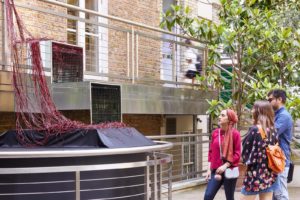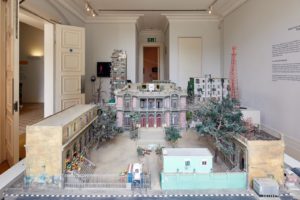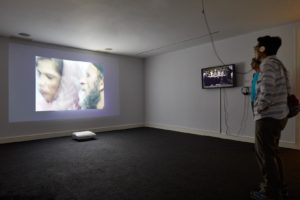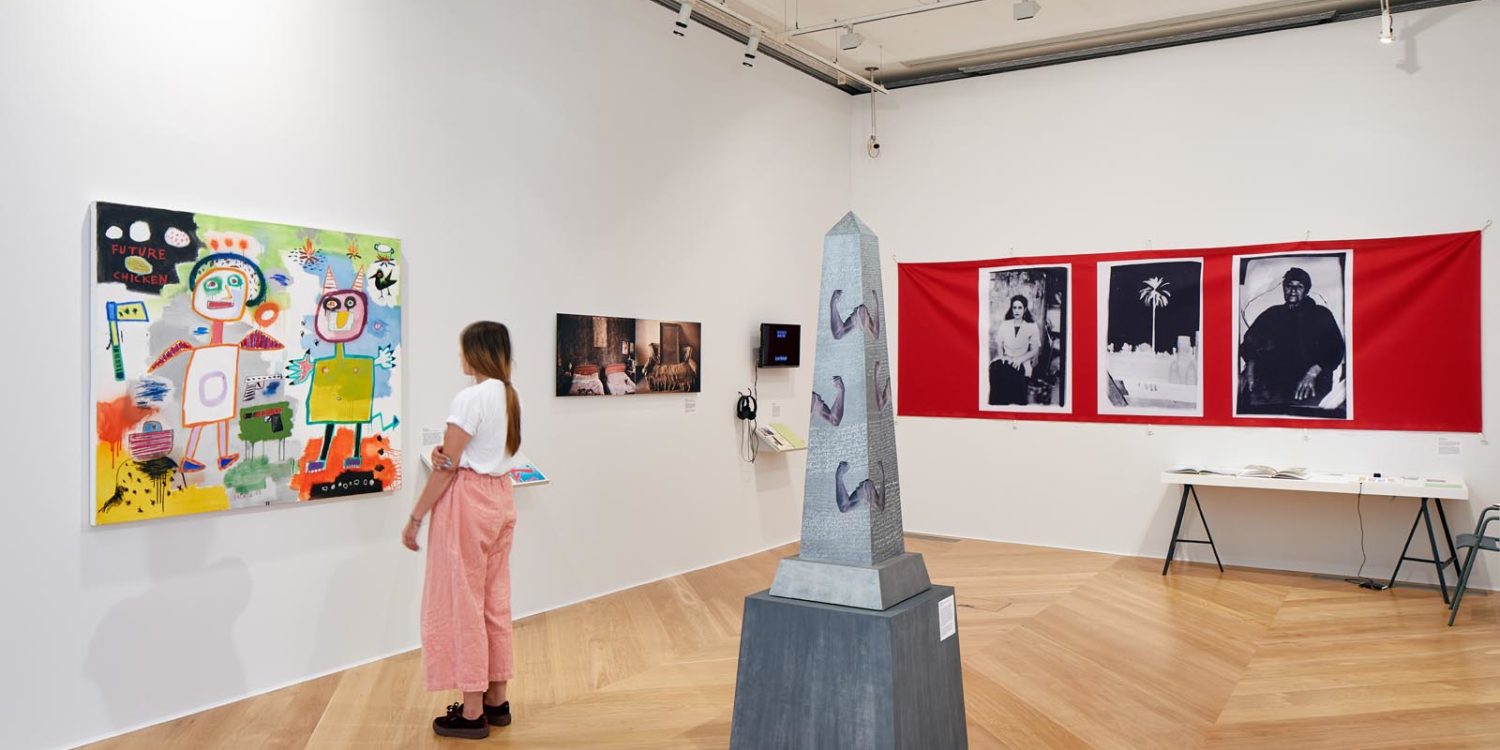Header image: “What do you mean, here we are?” Photo by Andy Stagg courtesy of The Mosaic Rooms 6 July – 15 September
Coming to an end this week at the Mosaic Rooms is What do you mean, here we are? a retrospective of the renowned Townhouse Gallery in Cairo, Egypt. Founded in 1998, Townhouse emerged onto a scene dominated by the Egyptian Ministry of Culture and its private affiliates. As one of the first independent art spaces in Cairo, Townhouse has borne witness to an unusual and intriguing trajectory.
Through a series of visual, video material and sound art as well as pamphlets, catalogues and ephemera, this exhibition tells the story of Townhouse’s evolution from a modest start in the backstreets of downtown Cairo to its emergence at the centre of the regional contemporary art scene, and further across more recent periods of turmoil and re-configuration. The exhibition is the second in The Mosaic Rooms’ 10th Anniversary exhibition series which looks at modernist and contemporary art from Egypt, Iran and Morocco.
We were lucky enough to be shown round the exhibition by co-curator Mariam Elnozahy, who we interviewed about the exhibition, Townhouse’s place in the Egyptian art scene, and more.

Khaled Kaddal, Boundaries of a Multiverse, 2018. Multi channel installation. Photo by Andy Stagg courtesy of The Mosaic Rooms
The name of the exhibition, What do you mean, here we are? is taken from an interview with Townhouse’s co-founder and director William Wells. Can you explain the rationale behind the exhibition name, and how you worked in relation to it – did it proceed the selection, or illuminate your choices afterwards?
“What do you mean, here we are” is taken from this in Bidoun magazine, where the interviewer states: “Here we are” and William responds almost obstinately, “What do you mean, here we are.” I thought it was a catchy aphorism that spoke a lot to how we feel when people express shock or surprise that Townhouse is still operating. Given the tumultuous events of the past few years, and the volatile political climate in Egypt, people’s reactions to Townhouse are more often that of surprise than anything else. Because we were embarking on a retrospective in London, I wanted our exhibition title to challenge this “shock factor” or notion of “surprise” that many people have (and primarily foreign Westerners) at the existence and flourishing nature of an independent arts institution in Cairo.
The Townhouse exhibition brings a very palpable sense of place from one building to another, and from one hectic city to another. How did you go about transposing the essence of Townhouse, and Cairo, onto that of Mosaic Rooms? Do you see much of Cairo in London?
Hmm Cairo in London…not at all! I feel like the only traces of similarities between Cairo and London are those that stem from the colonial encounter. As for transposing the essence of Townhouse to the Mosaic Rooms, we wanted to introduce the viewer to the neighbourhood and the area of Cairo in which we operate. The first room tries to transport the viewer to our reality in Cairo through Wouter and Elke’s legendary maquette and a series of videos that bring that maquette to life.

Model Citizens by artists Wouter Osterholt and Elke Uitentius. Photo by Andy Stagg courtesy of The Mosaic Rooms
Many of the artists featured in the exhibition have immensely benefitted from Townhouse as an incubation space; from having their first exhibition there, to being offered opportunities to experiment and grow as artists. Can you tell us more about what Townhouse currently offers to artists in Cairo and beyond? And what role do you think that Townhouse, and independent art spaces in general, have in today’s society?
Currently, Townhouse is working on opening a large number of studio spaces for both Egyptian and foreign artists. We also hold workshops, cultural programs, and educational programs for artists and non artists alike. Of course, we also offer exhibition spaces that can allow artists to work on very large scales, which is rare in Cairo.
How would you describe the current art scene in Cairo, and where does Townhouse fit into that?
The current independent arts scene in Cairo is as it has been for the past 20 years – raw, vibrant, surprising, and riddled with challenges! While there are many obstacles to overcome – from political, social, and economic obstacles to obstacles that deal with the personal and psychological intricacies of artistic production – there is a lot of work being produced that really pushes the envelope, and explores the bounds of creativity and imagination. At Townhouse, we work to remain as porous as possible so that the aforementioned sort of creativity and imaginative energies flow in and out of the space with ease.

“What do you mean, here we are?” Photo by Andy Stagg courtesy of The Mosaic Rooms 6 July – 15 September
This exhibition celebrates Townhouse’s rich, 20 year history. What do you see in the future for the gallery? And do you envision further collaboration with artists or institutions in the UK?
I would love to collaborate further with artists and institutions in the UK, and we have lots of ideas in the works right now! I think exchanges and traveling can be really valuable – especially outside of London – where I feel like there are large parallels that we can draw between the Egyptian and UK artistic and cultural communities.
What do you mean, here we are? runs until 15 September at the The Mosaic Rooms, Tower House, 226 Cromwell Road, London SW5 0SW (free entry). Check out their fantastic programme for the rest of the year here.

